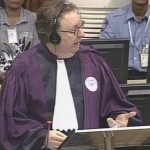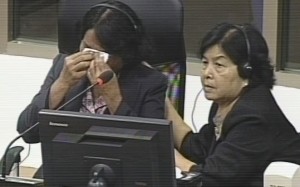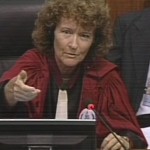Even the Cockroaches and the Rats Could Not Escape Kraing Ta Chan Security Center
Fresh from the King’s Birthday holiday, the Trial Chamber of the ECCC today continued its evidentiary hearings in Case 002/02. Testimony again centered on Kraing Ta Chan prison. It was alleged in the closing order in Case 002/02 that the “total number of those killed at Kraing Ta Chan was greater than 15,000,” although defense lawyers argue that this number has been inflated in the attempt to re-write the narrative of what happened at the notorious security center.
Witness 2-TCW-986, Vorng Sarun, 61 years old, was born November 28, 1954, in Dorng Tong District, Kampot Province. Her husband was Prach Sonn (alias Sett). A mother of four, she is now retired from her post-1979, career as a primary school teacher.
Vorng Sarun confirmed to President Nil Nonn, that none of her relatives were civil parties in Case 002/02, and that she had taken an oath to tell the truth. After informing her of her right against self-incrimination, and determining that the witness had not been interviewed by the Office of the Co-Investigating Judges, Judge Nil gave the floor to the co-prosecutors.
Co-Prosecutor Dale Lysak questioned Ms. Vorng for the whole morning. It was an emotionally trying experience for the witness. At one point, when she was recounting the interrogation she suffered when she first arrived at the prison, she became so overwhelmed that the President ordered a short break to give her an opportunity to compose herself.
Vorng Sarun was married by Angkar to her husband, Prach Sonn, a surgeon, in 1973. Ms. Vorng explained that people said that her husband was from Vietnam because he had worked as a medic in Hanoi, but he was really pure Khmer.
The couple had worked together at Hospital 22, a military hospital, until Prach Sonn was accused of belonging to a spy ring. He was arrested during the rice planting season, sent to Kraing Ta Chan and executed within a week of his arrival.
A frightening arrest
After her husband was taken away, Vorng Sarun was put in a Widow’s Unit cooperative where she was assigned dam building duties. On May 23, 1977, while returning from the dam worksite, two military men stopped her and told her that she was going home. When she asked to get her belongings, the men offered to get her belongings for her. She knew then that ‘going home’ was a pretext, and that she was to going to prison. She had her year-old baby with her and nothing else but one set of clothes for each of them. Ms. Vorng implored the militia to tell her the truth about what happened to her husband to no avail. She now considers the military men to be a class below ordinary people.
The witness was taken to a place near a lake, surrounded by barbed wire. Inside the barbed wire there was a building. “There was a door,” she said, “and the door was closed. I was let into that place and that place was closed. I thought I would die.” She was walked through a hall with wooden planks, locked in a cell with her baby, her ankles shackled.
“My husband was already dead, and I thought I was also going to be die and my baby, too.” The witness was obviously anguished by her memories, the person sitting next to her gently patting her on the back in support.
Vorng Sarun was locked and shackled in the cell for seven days. She was given just a ladle of gruel soup. The soup had no salt. She did not eat the soup, but gave it all to her baby. The child cried for three days. Someone came and hit her baby. After someone told her to be strong, she started eating again.
“After seven days, I was interrogated,” Ms. Vorng said, shaking. “I was falling down repeatedly because of no food. I was beaten. I was numb in my ankles. When I arrived at my interrogation, I was asked to sit in a metal chair…”
At this point, the sobbing witness asked for a break: “I have no strength,” she said. The President quickly granted her request.
When composed, Ms. Vorng testified that “there were three buildings” at Kraing Ta Chan. “One on the north side and another one in the east. And there was another building elsewhere on the site.” The buildings had wooden plank walls.
Forty prisoners were in each building, sleeping toe to toe. The people were skinny; they could hardly walk.
“I was thinking that when I was in the building I would die,” Ms. Vorng reported. “And there was a fence, a barbed wire fence. In the place where I was sleeping, there were wire nets below us so even the cockroaches or the rats could not escape from that place. I thought that was where I would die.”
Starvation leads to eating rat
Ms. Sarun graphically informed the court of the near-starvation conditions at the prison with a story:
In the building where I stayed, there was a man named Jun [phonetic], a former Khmer soldier who was blind in both eyes. He had a place in the same building. He was so hungry he stole chickens. After he was caught, he was not allowed to stay out.
There were many mice, which he caught and ate alive out of hunger. He gave some to his baby and wife, but his wife did not want any. After a month, his body became swollen from malnutrition. Not given any medical treatment, he died. His son also died.
His body was dragged across the wooden floor to the exit door. But, the corpse caught on the barbed wire around the door. I saw wounds on the dead body.
And that’s what I actually saw with my own eyes while I was there.
Relationship with Ta Ann
The Co-prosecutor Dale Lysak informed Vorng Sarun that another witness had testified before the court that Ms. Vorng had had a relationship with Ta Ann, the chief of Kraing Ta Chan.
Ms. Sarun emphatically denied the accusation: “This is simply a rumor. Ta Ann was the chief. I certainly did not have a relationship with the person who killed my husband. I was a prisoner there so I could not have had a relationship with the person who killed my husband.”
Judge Claudia Fenz
Judge Claudia Fenz picked up the thread of the examination by reminding the witness that, if she did not remember, she could say that she did not remember, and that if she was finding it too emotional, to tell the Bench so immediately.
Judge Fenz teased out a story that Ms. Vorng had told of seeing skeletal remains near a tree where her husband was killed.
The witness said that she had seen bones, skeletal remains, when she had been walking near the tree. Judge Fenz asked her to clarify whether there were half-buried bodies or only bones.
Ms. Vorng had seen “skeletal remains or bones. Everything was there.”
Judge Fenz wanted Vorng Sarun to elaborate on whether she had witnessed any executions. “You saw people sharpening the long knives,” she asked “and then cleaning the blood. But did you see executions?”
Ms. Vorng was firm that she did not see executions, “but (she) saw the blood stains.” She reiterated, “knives were sharpened and music was played.” (Music was played so that the prisoners would not hear the screams of those being executed).
Judge Fenz inquired as to how Ms. Sarun knew that the people who were taken away were killed and not just sent away. Ms. Sarun had learned this from the other prisoners that were detained before her, from people like Rom who were trusted.
Cross-Examination
Anta Guissé, Khieu Samphan international defense counsel, was next. (The lawyers for Khieu Samphan went first today although, in the normal course of events, they are usually second after Nuon Chea’s defense team).
Ms. Guissé focused on the alleged relationship that Ms. Vorng had had with the chief of the prison, Ta Ann, as testified to by her fellow prisoner, Soy Sen, on March 25, 2015.
Ms. Vorng confirmed that Soy Sen was not Ms. Vorng’s boss but that he had worked with the women. Soy Sen had merely received orders and passed them on to Ms. Vorng’s group.
In 1979, when the Vietnamese came, Ms. Vorng had fled into the forest with Ta Ann but that they were then separated because she had a baby.
Since 1979, Ms. Vorng has spoken to Soy Sen only once, when he telephoned her. Three years ago, Ms. Vorng had left her personal information with an elderly man she met during a visit to Kraing Ta Chan. She surmised that Soy Sen got her number from him. Ms. Vorng insisted that she has not met with Soy Sen since their brief phone contact.
As she had explained to Soy Sen in their phone conversation, Ms. Vorng thought the rumor that she had a love affair with Ta An was spread because, as she and Ta Ann had fled together, many people concluded that they were together. But they had not planned it, and later went their separate ways.
Victor Koppe, Nuon Chea International Defense Counsel, challenged the witness on some points of her testimony.
Firstly, Mr. Koppe raised the possibility that Vorng Sarun had never actually seen the skeletons but just heard rumors of them. He quizzed whether she could distinguish what she saw a few years ago when she went to Kraing Ta Chan from what she remembers from when she was imprisoned there.
Ms. Vorng surprisingly answered by contradicting her prior statement: “During my detention, of course I did not see the skeletons. People were killed and buried in the pits. It was only after I came back that things were exhumed that I saw the skeletons.”
Mr. Koppe followed up with whether the witness actually remembered hearing the loud speakers or if someone had told her about the music. Ms. Vorng was adamant that she had heard the loudspeakers being played although she did not know where they had been located.
Ms. Vorng refuted Mr. Koppe’s theory that Soy Sen might have told her about the loud speakers:
We were the victims, we whispered to each other. When the loud speakers were played, prisoners were locked inside. It was true that prisoners walked out (to the pits). They could not escape. They had no energy to escape because they had no food. I peeked through the cracks and saw that they were not tied. I do not know where they [the loudspeakers] were installed but (the sound came) from the house of the chief. Pol Pot songs were played but I cannot remember the scripts. The volume was very high. We could not hear anything but the sounds from the loud speakers.
Mr. Koppe moved on to whether Vorng Sarun really witnessed anyone getting killed. Ms. Vorng was clear that she had never witnessed executions. But she had seen people sharpening their knives and then later coming to the pond to wash their blood- soaked clothes.
Mr. Koppe wanted to know why she did not see any corpses when Soy Sen said there were so many. Ms. Sarun posited that, because Say Sen was a prisoner who could go outside the prison compound, he may have been aware of such other things. Mr. Koppe probed deeper asking how it was possible that she did not see any of what Soy Sen says he did?
Ms. Vorng responded: “We were prisoners and we couldn’t go anywhere out of our own will. We were like a herd of cattle under their watch. We could not move freely. Probably that is the reason why we did not see any dead bodies.”
Vorng Sarun was never a member of the Khmer Rouge. She had only been on the “ordinary medical staff” at the hospital:
I was ordinary medical staff. The doctor examined the patients. We were told which injections to give and I would just give the injections. Then we would clean the wounds and wrap them. I did what I was told. One week, I would do the wound dressings; one week, I would do injections; and, one week, I would cook.
Discrimination was not an issue as Ms. Vorng had never treated anyone who was a villager in the military hospital.
Drawing his examination to a close and prompted by the presence of a representative of the Transcultural Psychological Organization (TPO) sitting next to the witness, Mr. Koppe asked Vorng Sarun if she was suffering from any mental problems.
Ms. Vorng completed her testimony strongly: “No I have not. If I had any mental problems I would not be fit to teach students.”
Court adjourned until tomorrow, May 19, 2015, when it will hear the testimony of Witness: 2-TCW-836.






